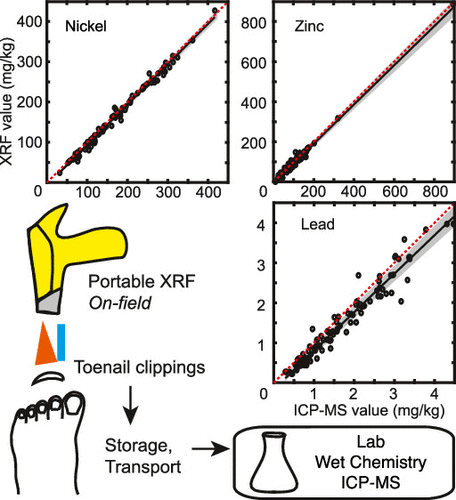当前位置:
X-MOL 学术
›
Environ. Sci. Technol.
›
论文详情
Our official English website, www.x-mol.net, welcomes your feedback! (Note: you will need to create a separate account there.)
Portable X-ray Fluorescence as a Rapid Determination Tool to Detect Parts per Million Levels of Ni, Zn, As, Se, and Pb in Human Toenails: A South India Case Study
Environmental Science & Technology ( IF 11.4 ) Pub Date : 2021-09-16 , DOI: 10.1021/acs.est.1c00937 Mayuri Bhatia 1 , Aaron J Specht 2, 3 , Vallabhuni Ramya 1 , Dahy Sulaiman 1 , Manasa Konda 1 , Prentiss Balcom 4 , Elsie M Sunderland 2, 4 , Asif Qureshi 1, 5
Environmental Science & Technology ( IF 11.4 ) Pub Date : 2021-09-16 , DOI: 10.1021/acs.est.1c00937 Mayuri Bhatia 1 , Aaron J Specht 2, 3 , Vallabhuni Ramya 1 , Dahy Sulaiman 1 , Manasa Konda 1 , Prentiss Balcom 4 , Elsie M Sunderland 2, 4 , Asif Qureshi 1, 5
Affiliation

|
Chronic exposure to inorganic pollutants adversely affects human health. Inductively coupled plasma mass spectrometry (ICP–MS) is the most common method used for trace metal(loid) analysis of human biomarkers. However, it leads to sample destruction, generation of secondary waste, and significant recurring costs. Portable X-ray fluorescence (XRF) instruments can rapidly and nondestructively determine low concentrations of metal(loid)s. In this work, we evaluated the applicability of portable XRF as a rapid method for analyzing trace metal(loid)s in toenail samples from three populations (n = 97) near the city of Chennai, India. A Passing–Bablok regression analysis of results from both methods revealed that there was no proportional bias among the two methods for nickel (measurement range ∼25 to 420 mg/kg), zinc (10 to 890 mg/kg), and lead (0.29 to 4.47 mg/kg). There was a small absolute bias between the two methods. There was a strong proportional bias (slope = 0.253, 95% CI: 0.027, 0.614) between the two methods for arsenic (below detection to 3.8 mg/kg) and for selenium when the concentrations were lower than 2 mg/kg. Limits of agreement between the two methods using Bland–Altman analysis were derived for nickel, zinc, and lead. Overall, a suitably calibrated and evaluated portable XRF shows promise in making high-throughput assessments at population scales.
中文翻译:

便携式 X 射线荧光作为一种快速测定工具,可检测人体脚趾甲中的百万分之一水平的 Ni、Zn、As、Se 和 Pb:印度南部案例研究
长期接触无机污染物会对人类健康产生不利影响。电感耦合等离子体质谱法 (ICP-MS) 是用于人体生物标志物的痕量金属 (样体) 分析的最常用方法。然而,它会导致样品破坏、二次废物的产生和大量的经常性成本。便携式 X 射线荧光 (XRF) 仪器可以快速且无损地确定低浓度的金属(类)。在这项工作中,我们评估了便携式 XRF 作为一种快速分析三个人群(n= 97)在印度钦奈市附近。对两种方法的结果进行的 Passing-Bablok 回归分析表明,两种方法对镍(测量范围 ∼25 至 420 mg/kg)、锌(10 至 890 mg/kg)和铅(0.29至 4.47 毫克/千克)。两种方法之间存在小的绝对偏差。当浓度低于 2 mg/kg 时,砷(低于检测到 3.8 mg/kg)和硒的两种方法之间存在很强的比例偏差(斜率 = 0.253, 95% CI:0.027, 0.614)。使用 Bland-Altman 分析的两种方法之间的一致性限制是针对镍、锌和铅得出的。总体而言,经过适当校准和评估的便携式 XRF 有望在人口规模上进行高通量评估。
更新日期:2021-10-06
中文翻译:

便携式 X 射线荧光作为一种快速测定工具,可检测人体脚趾甲中的百万分之一水平的 Ni、Zn、As、Se 和 Pb:印度南部案例研究
长期接触无机污染物会对人类健康产生不利影响。电感耦合等离子体质谱法 (ICP-MS) 是用于人体生物标志物的痕量金属 (样体) 分析的最常用方法。然而,它会导致样品破坏、二次废物的产生和大量的经常性成本。便携式 X 射线荧光 (XRF) 仪器可以快速且无损地确定低浓度的金属(类)。在这项工作中,我们评估了便携式 XRF 作为一种快速分析三个人群(n= 97)在印度钦奈市附近。对两种方法的结果进行的 Passing-Bablok 回归分析表明,两种方法对镍(测量范围 ∼25 至 420 mg/kg)、锌(10 至 890 mg/kg)和铅(0.29至 4.47 毫克/千克)。两种方法之间存在小的绝对偏差。当浓度低于 2 mg/kg 时,砷(低于检测到 3.8 mg/kg)和硒的两种方法之间存在很强的比例偏差(斜率 = 0.253, 95% CI:0.027, 0.614)。使用 Bland-Altman 分析的两种方法之间的一致性限制是针对镍、锌和铅得出的。总体而言,经过适当校准和评估的便携式 XRF 有望在人口规模上进行高通量评估。



























 京公网安备 11010802027423号
京公网安备 11010802027423号